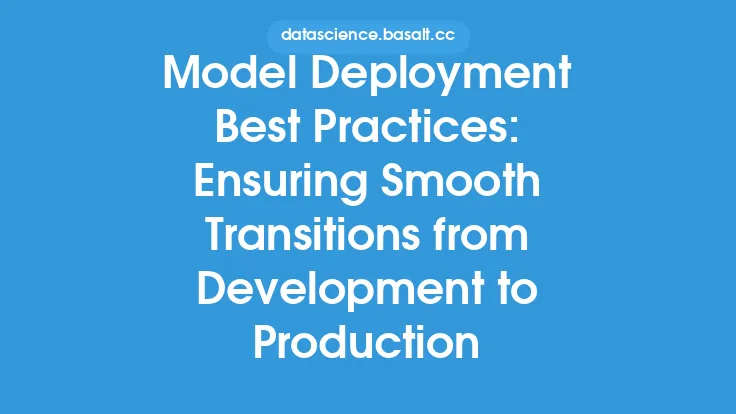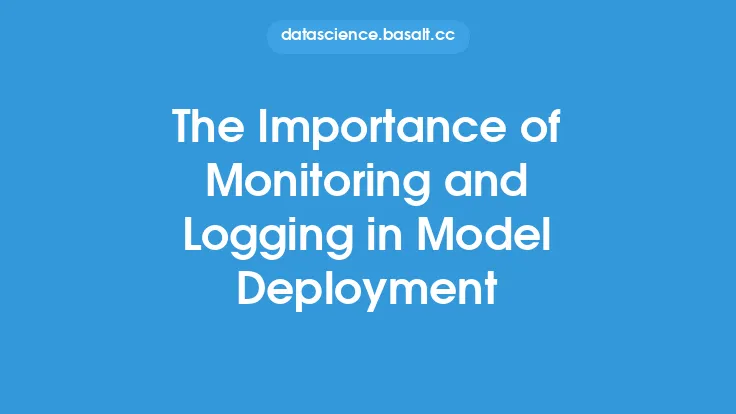As machine learning models become increasingly integral to business operations and decision-making processes, ensuring their security during deployment is crucial. Model deployment security is a critical aspect of the machine learning lifecycle, as it protects models from unauthorized access, tampering, and theft. In this article, we will delve into the importance of model deployment security, common threats and vulnerabilities, and best practices for protecting models from unauthorized access.
Understanding Model Deployment Security
Model deployment security refers to the practices and techniques used to protect machine learning models from unauthorized access, use, or modification. This includes ensuring that models are deployed in a secure environment, with proper access controls, encryption, and monitoring. Model deployment security is essential because machine learning models often contain sensitive information, such as proprietary algorithms, data, and business logic. If a model is compromised, it can lead to significant financial losses, reputational damage, and legal liabilities.
Common Threats and Vulnerabilities
Machine learning models are vulnerable to various threats, including:
- Model theft: Unauthorized individuals or organizations may attempt to steal or reverse-engineer a model to gain access to its proprietary algorithms or data.
- Model tampering: Malicious actors may try to modify a model to alter its behavior, compromise its accuracy, or inject malware.
- Data breaches: Sensitive data used to train or deploy a model may be compromised, leading to unauthorized access or theft.
- Denial of Service (DoS) attacks: Models may be targeted with DoS attacks, which can overwhelm the model with traffic, causing it to become unresponsive or crash.
- Inference attacks: Attackers may attempt to infer sensitive information about a model or its data by analyzing its inputs and outputs.
Best Practices for Model Deployment Security
To protect machine learning models from unauthorized access, the following best practices should be implemented:
- Access control: Implement role-based access control (RBAC) to ensure that only authorized individuals have access to the model, its data, and its deployment environment.
- Encryption: Encrypt models, data, and communications to prevent unauthorized access or eavesdropping.
- Secure deployment environment: Deploy models in a secure environment, such as a virtual private cloud (VPC) or a containerized environment, to isolate them from other systems and networks.
- Monitoring and logging: Monitor and log model activity, including inputs, outputs, and performance metrics, to detect potential security threats or anomalies.
- Model versioning: Implement model versioning to track changes to the model, its data, and its deployment environment, and to ensure that changes are properly tested and validated.
- Secure data storage: Store sensitive data used to train or deploy a model in a secure location, such as a encrypted database or a secure file system.
Technical Considerations
From a technical perspective, model deployment security requires careful consideration of the following factors:
- Containerization: Containerization using tools like Docker can help isolate models from other systems and networks, and provide an additional layer of security.
- Orchestration: Orchestration tools like Kubernetes can help manage and scale model deployments, while also providing features like network policies and secret management.
- API security: APIs used to interact with models should be secured using techniques like authentication, authorization, and encryption.
- Model serving: Model serving platforms like TensorFlow Serving, AWS SageMaker, and Azure Machine Learning provide built-in security features, such as access control and encryption, to protect models and their data.
Conclusion
Model deployment security is a critical aspect of the machine learning lifecycle, as it protects models from unauthorized access, tampering, and theft. By understanding common threats and vulnerabilities, and implementing best practices like access control, encryption, and monitoring, organizations can ensure the security and integrity of their machine learning models. Additionally, technical considerations like containerization, orchestration, API security, and model serving should be carefully evaluated to ensure that models are deployed in a secure and scalable environment. By prioritizing model deployment security, organizations can protect their intellectual property, prevent financial losses, and maintain the trust of their customers and stakeholders.





